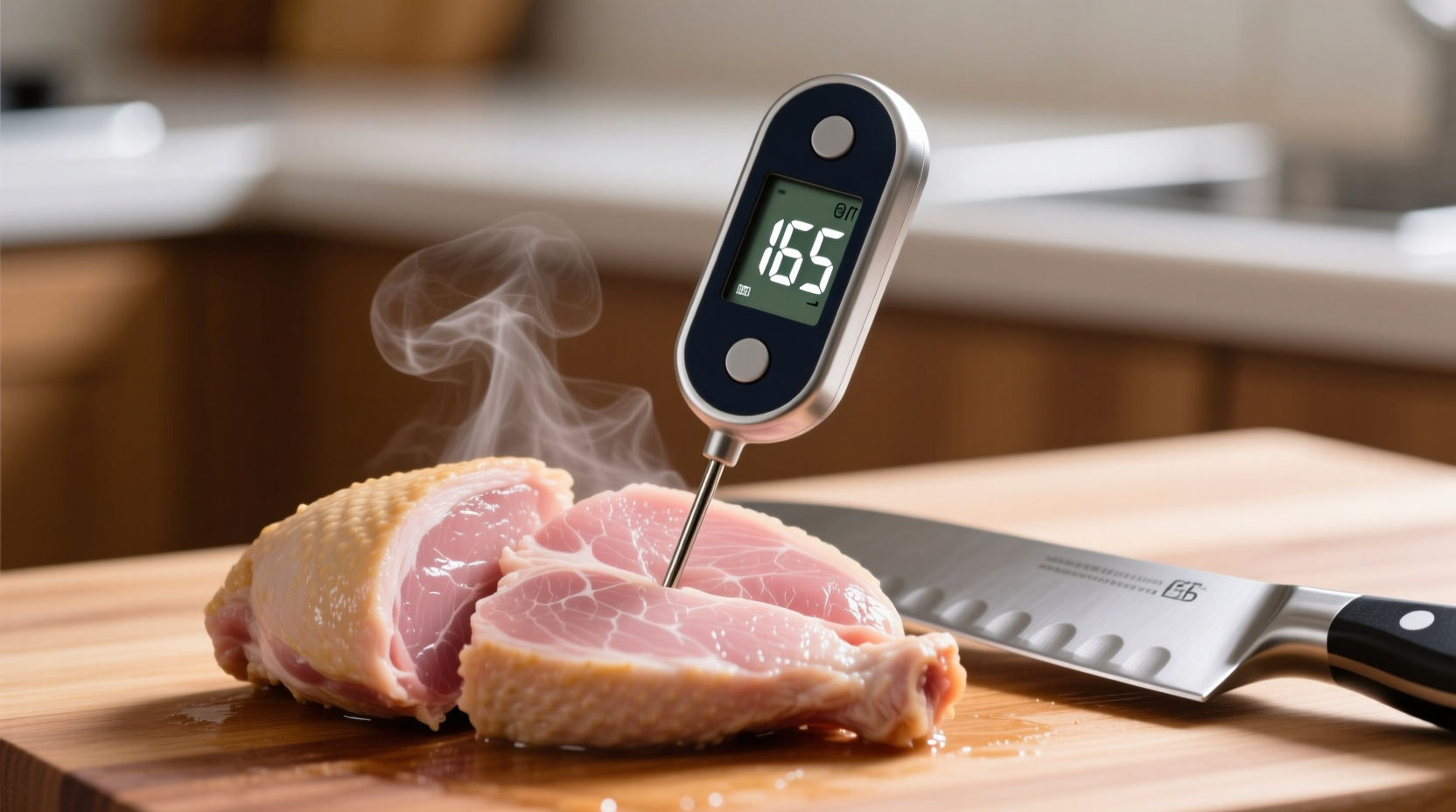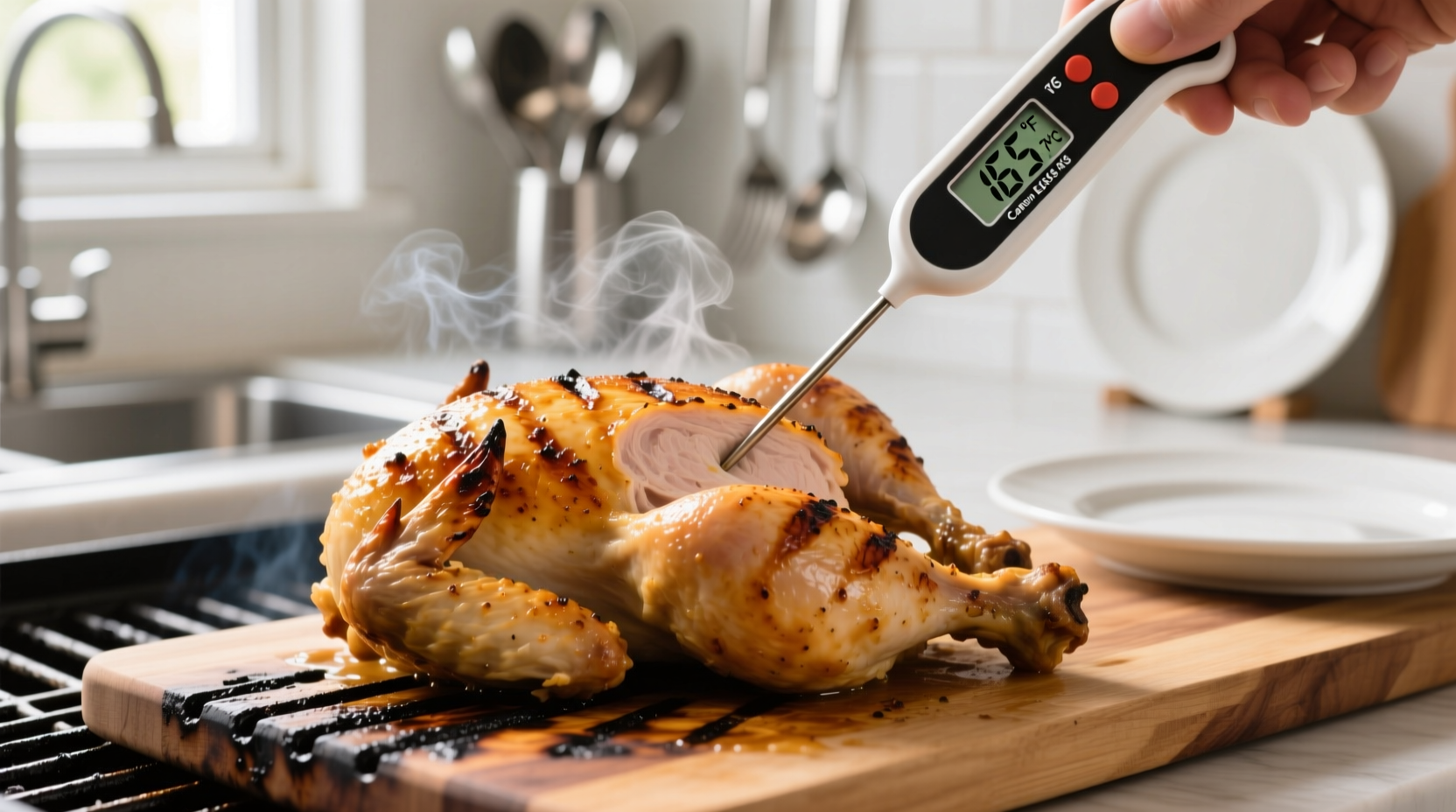The safe internal temperature for fully cooked chicken is 165°F (74°C) as measured by a food thermometer in the thickest part of the meat. This temperature destroys harmful bacteria like salmonella and campylobacter, ensuring your chicken is safe to eat while maintaining optimal texture and juiciness.
Why Chicken Temperature Matters for Food Safety
Understanding the precise temperature for cooked chicken isn't just about perfection—it's a critical food safety requirement. Raw poultry commonly contains harmful bacteria that can cause serious foodborne illness. The USDA Food Safety and Inspection Service mandates 165°F (74°C) as the minimum safe temperature because at this point, dangerous pathogens are instantly destroyed.
Many home cooks rely on visual cues like color or juice clarity, but these methods are unreliable. Chicken can appear done while still harboring harmful bacteria, or remain slightly pink even when properly cooked. A food thermometer provides the only accurate assessment of doneness.
| Temperature Range | Bacterial Safety Status | Recommended Action |
|---|---|---|
| Below 140°F (60°C) | Danger Zone: Bacteria multiply rapidly | Continue cooking immediately |
| 140-150°F (60-66°C) | Requires sustained time to kill bacteria | Hold for 26+ minutes for safety |
| 155°F (68°C) | Requires 47 seconds to eliminate pathogens | Acceptable with precise timing |
| 165°F (74°C) | Instant pathogen destruction | USDA standard for immediate safety |
How to Measure Chicken Temperature Correctly
Proper thermometer usage makes all the difference in achieving accurate readings:
- Use an instant-read digital thermometer for quickest, most precise results
- Insert into the thickest part of the meat, avoiding bones which conduct heat differently
- Check multiple spots in larger pieces like whole chickens or roasts
- Clean between readings with hot, soapy water to prevent cross-contamination
The FDA Food Code confirms that digital thermometers provide the most reliable method for home cooks to verify chicken doneness. Unlike dial thermometers, digital models give readings in seconds rather than minutes, preventing unnecessary heat loss during checking.

Temperature Guidelines for Different Chicken Cuts
While the safe temperature remains consistent across all poultry products, cooking times vary significantly by cut:
- Chicken breasts: Cook to 160-162°F then remove from heat; carryover cooking will reach 165°F during resting
- Thighs and drumsticks: Can be removed at 160°F as dark meat benefits from slightly lower final temperature
- Whole chicken: Check both breast and thigh areas; the breast will reach temperature first
- Ground chicken: Must reach 165°F throughout due to increased surface area for bacteria
According to research published in the Journal of Food Protection, dark meat requires slightly different handling than white meat due to its higher fat content and connective tissue. While the safety standard remains 165°F, many professional chefs remove dark meat at 160°F and allow carryover cooking to reach the target temperature, resulting in more tender results.
Resting Time: The Critical Final Step
Many home cooks make the mistake of serving chicken immediately after it reaches 165°F. Proper resting allows temperature to stabilize and juices to redistribute:
- Small cuts (breasts, cutlets): Rest 5-8 minutes
- Large cuts (thighs, drumsticks): Rest 10-15 minutes
- Whole chicken: Rest 15-20 minutes before carving
During this resting period, the internal temperature typically rises 3-5°F (carryover cooking), then gradually decreases. This process allows proteins to relax, preventing dry, stringy chicken. The USDA confirms that properly rested chicken maintains safety while improving texture.
Common Temperature Mistakes to Avoid
Even experienced cooks sometimes fall into these temperature traps:
- Thermometer placement errors: Inserting too close to bone or fat pockets gives false readings
- Insufficient checking: Checking only one spot in unevenly shaped pieces
- Ignoring carryover cooking: Overcooking by not accounting for temperature rise after removal from heat
- Relying on color: Assuming white meat = done (USDA research shows chicken can remain pink up to 175°F)
The CDC reports that improper cooking temperature accounts for approximately 23% of poultry-related foodborne illness cases annually. Using a thermometer consistently reduces this risk dramatically.
When Lower Temperatures Might Be Acceptable
While 165°F remains the USDA standard, some culinary professionals use lower temperatures with precise timing:
According to sous vide cooking guidelines from the National Center for Home Food Preservation, chicken held at 145°F (63°C) for 9+ minutes achieves equivalent safety to 165°F instantly. However, this precision cooking method requires specialized equipment most home kitchens lack. For conventional cooking methods, 165°F remains the only reliably safe standard without professional monitoring.
Essential Tools for Perfect Chicken Every Time
Investing in these temperature-focused tools transforms chicken cooking:
- Digital instant-read thermometer: Thermapen ONE or similar models provide readings in 2-3 seconds
- Leave-in probe thermometer: For roasting whole birds or larger cuts
- Calibration tools: Ice water (32°F/0°C) or boiling water (212°F/100°C) tests ensure accuracy
- Reference chart: Keep USDA temperature guidelines visible in your kitchen
Regular thermometer calibration is essential—the National Institute of Standards and Technology recommends checking accuracy monthly. An improperly calibrated thermometer could provide readings 5-10°F off, creating serious food safety risks.
Practical Temperature Tips for Busy Cooks
When time is limited but safety can't be compromised:
- Bring chicken close to room temperature before cooking for more even heating
- Use a thermometer with a thin probe for quick, minimally invasive checks
- For grilling, create a two-zone fire to move chicken to indirect heat while checking temperature
- Keep thermometers clean and accessible—don't search for it when chicken is nearly done
Remember that carryover cooking continues even after removing chicken from heat sources. The American Meat Science Association confirms that residual heat raises internal temperature 3-10°F depending on the cut's size and density. Planning for this prevents overcooking while maintaining safety.











 浙公网安备
33010002000092号
浙公网安备
33010002000092号 浙B2-20120091-4
浙B2-20120091-4